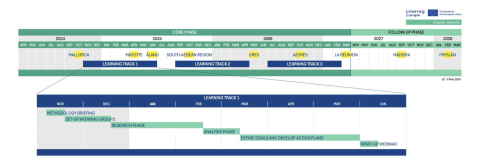Learning Tracks
During the first three years of Digital Islands project (2024 – 2027), 3 consecutive Learning Tracks are organised. Each track lasts for approximately 8 months and covers a different digitalisation topic. This gives partners the possibility to work on multiple regional digitalisation challenges and opportunities during the project lifespan. All partners participate in all three Learning Tracks.
Within the general topic of each track, we will identify specific sub-topics of shared importance for multiple partners. For each sub-topic we form a small working group of partners. Each Learning Track goes through the following phases:
-
Introduction: Partners identify ‘sub-topics’; specific areas of interest within the general track topic. Working groups are nominated around shared issues.
-
Working group activity: Groups of partners with a shared interest in a specific digitalisation challenge or opportunity work online to explore relevant experiences, and case examples. Partners develop an Action Plan for the adaptation and implementation of relevant practices in their respective regional contexts. Each partner participates in at least one group per Track, with the option to participate in more.
-
Wrap-up (1-2 months): Results of the working groups are captured in a summary document and presented to the consortium, stakeholders and other interested islands and actors via a webinar. A “highlights video” is also produced to wrap up the Track.
-
Implementation (post-Learning Track): Partners take up the regional implementation of concrete digitalisation initiatives and learnings, as laid out in their Action Plan. This work happens in parallel to the Digital Islands project, ideally leading to tangible results during the lifespan of the project.
The table below presents the topics and timeline of the consecutive Learning Tracks.
|
Learning Track Topic |
Timing |
Working group topics (examples for Track 2 & 3) |
| 1. Islands economies |
November 2024 - June 2025 |
1. Digital skills & tools for SMEs (in tourism and other existing sectors) |
| 2. Public Services |
September 2025 - April 2026 |
For example: |
| 3. Quality of Life |
July 2026 - February 2027 |
For example: |
Key concepts and definitions
Some key Interreg Europe concepts are explained below and applied to the Learning Track context.
Improved performance of policy instruments
The overall goal of all Interreg Europe projects is to improve the performance of regional policy instruments based on exchange of experience and capacity building. Policy improvements can take the form of new projects, changes in policy governance or revision of the (content) of the policy.
The table below presents the policy instruments targeted by the Digital Islands partners. In the Learning Track it is important that partners make clear how the various measures and initiatives identified in their Action Plan are linked to their regional policy.
Exchange of experience
Interreg Europe expects partners to improve the performance of their regional policies through exchange of experience. These experiences can be Good Practices (i.e. success stories). But lessons and insights from less successful interventions can be equally valuable learning material for policy improvement. Such case examples should certainly be considered in the Learning Tracks.
Interreg Europe prioritises interregional exchange and learning within partnerships. This means that inspiration for new digitalisation actions and policy improvements in the Learning Tracks should primarily come from other partners. However, if we find big knowledge gaps during the rack we can try to bring in external knowledge for instance from external speakers in Working Group sessions.
Finally, Interreg Europe asks all projects to contribute relevant Good Practices from partners to their programme database. We will use the wrap-up phase of each Learning Track to identify practices we can propose to Interreg for inclusion in their database.
Regional Stakeholder Group:
Interreg Europe requires each partner to create a regional stakeholder group with regional key actors in digitalisation. The stakeholders should be actively involved in identifying digitalisation challenges and opportunities, developing and implementing solutions at regional level and participating in and contributing to the international exchange and learning.
Partners should involve the relevant members of their Regional Stakeholders Groups in the Learning Tracks from the beginning: in defining the sub-topics, providing and analysing practices and case examples and developing and implementing the regional level Action Plan.
Action Plan
The Action Plan that partners develop in the Learning Track is not an Interreg requirement. It is intended as a tool for partners to prepare the adaptation and implementation of selected digitalisation improvements from their working group into their regional context.
It should be a practical plan made by and for partners and their regional stakeholders. The plan can be drafted in the local language. A template for the plan is provided as annex to this document.
Core phase and Follow-up phase of the project
An Interreg Europe project lasts for 4 years in total. In the case of Digital Islands, this is from April 2024 – March 2028. This lifespan is divided in two separate phases:
The Core phase lasts for 36 months (April 2024 – March 2027), dedicated to exchange of practices and experiences, resulting in the implementation of policy improvements. The Learning Tracks are concentrated in this phase, so that the Action Plans can still be implemented during the project lifetime. Ideally the results of the first learning tracks are already achieved in the Core phase.
The Follow-up phase lasts for 12 months (April 2027 – March 2028), dedicated to monitoring the results of the policy improvements. Implementation of some Action Plans can continue in this phase if needed.
Timeline
The diagram below shows the overall project timeline with the Learning Tracks and study visits. It zooms in on the timeline of the first Learning Track works steps, which are described in more detail in the following chapters.
